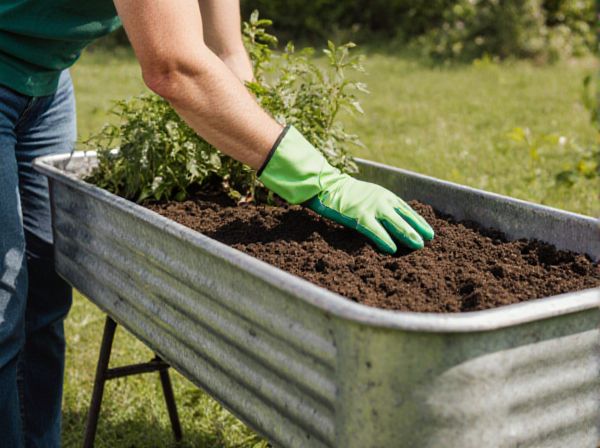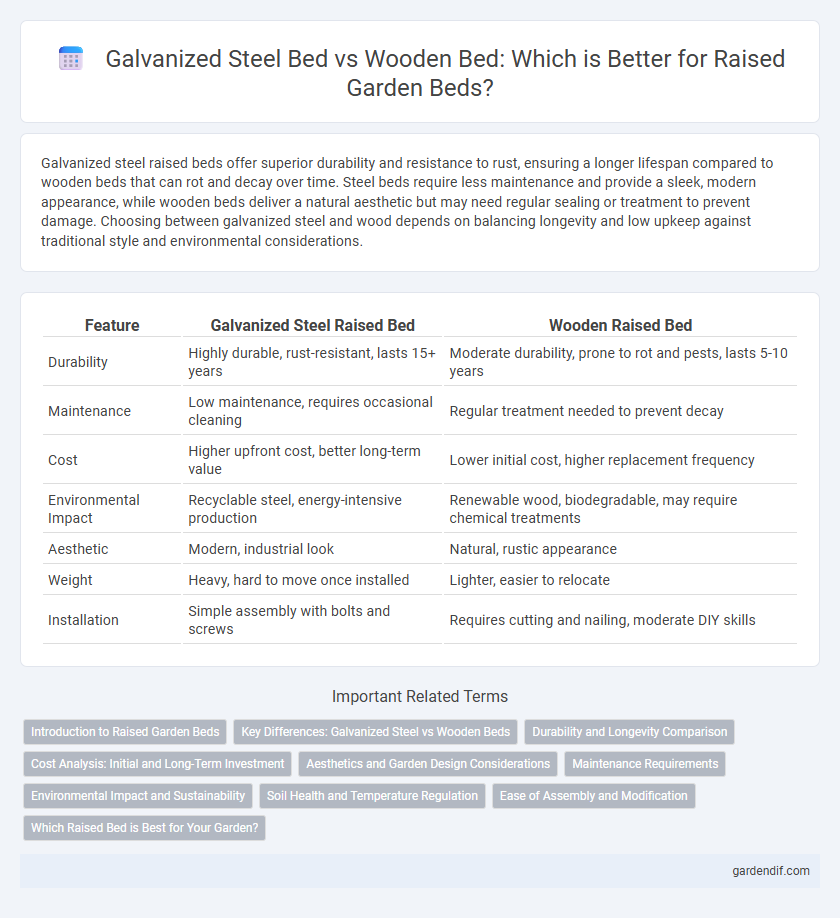
Galvanized steel bed vs Wooden bed Illustration
Galvanized steel raised beds offer superior durability and resistance to rust, ensuring a longer lifespan compared to wooden beds that can rot and decay over time. Steel beds require less maintenance and provide a sleek, modern appearance, while wooden beds deliver a natural aesthetic but may need regular sealing or treatment to prevent damage. Choosing between galvanized steel and wood depends on balancing longevity and low upkeep against traditional style and environmental considerations.
Table of Comparison
| Feature | Galvanized Steel Raised Bed | Wooden Raised Bed |
|---|---|---|
| Durability | Highly durable, rust-resistant, lasts 15+ years | Moderate durability, prone to rot and pests, lasts 5-10 years |
| Maintenance | Low maintenance, requires occasional cleaning | Regular treatment needed to prevent decay |
| Cost | Higher upfront cost, better long-term value | Lower initial cost, higher replacement frequency |
| Environmental Impact | Recyclable steel, energy-intensive production | Renewable wood, biodegradable, may require chemical treatments |
| Aesthetic | Modern, industrial look | Natural, rustic appearance |
| Weight | Heavy, hard to move once installed | Lighter, easier to relocate |
| Installation | Simple assembly with bolts and screws | Requires cutting and nailing, moderate DIY skills |
Introduction to Raised Garden Beds
Galvanized steel raised garden beds offer superior durability, rust resistance, and a modern aesthetic compared to traditional wooden beds prone to rot and insect damage. These steel beds maintain structural integrity for many years, reducing maintenance and replacement costs. Wood raised beds provide natural insulation for plant roots but require regular treatment and may deteriorate faster in moist conditions.
Key Differences: Galvanized Steel vs Wooden Beds
Galvanized steel beds offer superior durability and resistance to rust, pests, and rot compared to wooden beds, making them ideal for long-term outdoor use. Wooden beds provide natural insulation for plant roots and are often preferred for their aesthetic appeal and ease of customization but require regular maintenance to prevent decay. Steel beds generally have a longer lifespan and require less upkeep, while wooden beds offer environmental benefits such as biodegradability and use of renewable resources.
Durability and Longevity Comparison
Galvanized steel raised beds offer superior durability and resistance to rust, corrosion, and pests compared to wooden beds, ensuring a longer lifespan in various weather conditions. Wooden raised beds, while aesthetically pleasing and biodegradable, are prone to rot, insect damage, and warping, especially when untreated or exposed to moisture. Investing in galvanized steel raised beds provides a maintenance-free solution that can last decades, while wooden beds typically require regular sealing and replacement every few years.
Cost Analysis: Initial and Long-Term Investment
Galvanized steel raised beds typically involve a higher initial investment due to material and manufacturing costs but offer superior durability and resistance to weather, reducing replacement and maintenance expenses over time. Wooden raised beds are generally less expensive upfront, especially when using common lumber, but may require frequent treatments, repairs, or replacement because of rot, insect damage, and warping. Considering long-term investment, galvanized steel beds often provide better value through longevity and low maintenance, despite the higher upfront cost compared to traditional wooden beds.
Aesthetics and Garden Design Considerations
Galvanized steel raised beds offer a modern, sleek aesthetic with clean lines and a metallic finish that complements contemporary garden designs, while wooden beds provide a natural, rustic charm that blends seamlessly into traditional or cottage-style landscapes. Steel beds resist weathering and maintain their appearance over time without fading or rotting, enhancing long-term visual appeal with minimal maintenance. Wood allows for customizable stains and shapes but requires regular upkeep to prevent decay and preserve its warm, organic look within the garden.
Maintenance Requirements
Galvanized steel raised beds require minimal maintenance due to their rust-resistant coating, ensuring durability and longevity without frequent treatment. In contrast, wooden beds demand regular sealing or staining to prevent rot, insect damage, and weathering, increasing upkeep efforts. The low-maintenance nature of galvanized steel makes it ideal for gardeners seeking long-term, hassle-free bed solutions.
Environmental Impact and Sustainability
Galvanized steel raised beds offer durability and resistance to rot, reducing the need for frequent replacement and minimizing waste over time. Wooden beds, especially those made from sustainably harvested or reclaimed wood, provide a biodegradable option that supports carbon sequestration but may require treatment to prevent decay. Selecting sustainably sourced materials and considering lifespan are crucial for minimizing environmental impact and promoting sustainability in raised bed gardening.
Soil Health and Temperature Regulation
Galvanized steel raised beds offer superior durability and resist soil-borne pests, but they can absorb and retain more heat, potentially causing soil temperature fluctuations that stress plant roots. Wooden raised beds, especially those made from untreated cedar or redwood, provide better insulation, maintaining more stable soil temperatures and promoting healthier microbial activity essential for nutrient cycling. Soil health benefits from the natural aeration and moisture retention properties of wooden beds, while steel beds require careful management to prevent overheating and moisture loss.
Ease of Assembly and Modification
Galvanized steel raised beds offer superior ease of assembly with pre-drilled holes and lightweight panels that fit together quickly, reducing setup time significantly compared to wooden beds. Steel beds are highly customizable, allowing simple modifications like resizing or adding tiers by connecting additional panels without compromising structural integrity. Wooden raised beds require more tools and skill for assembly; modifications such as altering dimensions or reinforcing corners often involve cutting, drilling, and treating wood, which can be labor-intensive and time-consuming.
Which Raised Bed is Best for Your Garden?
Galvanized steel raised beds offer superior durability and resistance to pests, moisture, and rot compared to wooden beds, making them ideal for long-term use and low maintenance. Wooden raised beds provide a natural aesthetic and are often easier to customize but require regular treatment to prevent decay and insect damage. Choosing the best raised bed depends on prioritizing longevity and minimal upkeep (galvanized steel) versus affordability and traditional appearance (wood).
Galvanized steel bed vs Wooden bed Infographic

 gardendif.com
gardendif.com